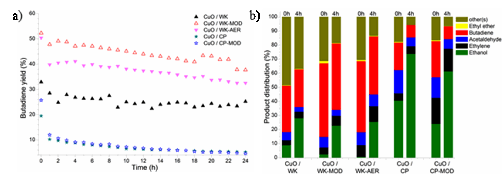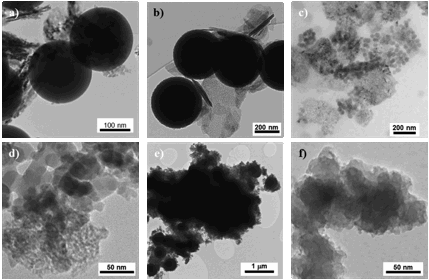

Catalytic conversion of bio-ethanol into 1,3-butadiene
Carlo Angelici, Bert M. Weckhuysen,* Pieter C. A. Bruijnincx*
Inorganic Chemistry and Catalysis, Debye Institute of Nanomaterials Science, Utrecht University, Utrecht, The Netherlands
*b.m.weckhuysen@uu.nl, p.c.a.bruijnincx@uu.nl
Introduction
The amount of bio-ethanol produced is rapidly growing as a result of the higher demand for biofuels and improved fermentation technologies. This increased availability also opens up opportunities for the use of bio-ethanol as an economically attractive feedstock for renewable bulk chemicals. [1] The Lebedev process, i.e. the conversion of ethanol to 1,3-butadiene, is a promising example of this approach. Indeed, the feasibility of this route has been recently positively assessed in a techno-economic study. [2] Importantly, The on-purpose production of butadiene through the Lebedev process presents an attractive solution to projected shortages in butadiene that result from the recent shifts to lighter, shale gas-based feedstocks for steam crackers. Here, we present our results on catalyst activity and stability for the ethanol-to-butadiene conversion with particular focus on the elucidation of structure-activity relationships, i.e. the influence of preparation method on morphology and amount/strength of the active sites.
Experimental details
Single and mixed oxides have been tested in the gas-phase synthesis of butadiene from ethanol (2% in N2, total gas flow 100 mL/min, 425°C). Various SiO2-MgO catalysts were obtained by (modified) co-precipitation (CP and CP-MOD) and wet-kneading procedures (WK, WK-MOD and WK-AER) Supported CuO/SiO2-MgO catalysts were prepared via incipient wetness impregnation (IWI). Extensive characterization of fresh and spent catalysts was performed with to assess morphology (TEM), acid-base properties (CO2- & NH3-TPD, Pyridine-IR and titration) and amount of coke produced (UV-Vis and IR).
Results and Discussion
Of the various (combinations of) bulk oxides tested for butadiene synthesis, SiO2-MgO mixed oxides proved the most interesting. The preparation method and the silica morphology were found to strongly influence both the activity and selectivity of the catalyst. The wet-kneaded samples performed best, giving the highest butadiene yield with little ethylene formation. The butadiene yield could be further boosted for all SiO2-MgO samples by impregnation with CuO. The best result, i.e. a butadiene yield as high as 50%, was achieved over the CuO/WK-AER catalyst (Figure 1), a catalyst consisting of relatively small silica particles. Limited deactivation was observed with time on stream for all the catalysts.
TEM studies showed the morphology to be quite different for the various SiO2-MgO samples (Figure 2); in particular, the wet-kneaded samples consist of silica spheres embedded in a thin MgO layer. Furthermore, these materials are less acidic than the others, in agreement with the lower amount of ethylene and coke produced for this catalyst. UV-Vis analysis provided interesting insights not only on coke formation, but also on the chemical nature of the CuO introduced as a promoter.
Figure 1. a) Butadiene yield with differently prepared CuO-containing catalysts with time on stream; b) product distribution at the start and after 4 h reaction.
Conclusions
The efficient and competitive synthesis of 1,3-butadiene from bioethanol would be of great economic importance. Our results show that catalyst preparation greatly influences butadiene yield and clear understanding of the underlying structure-function relation will aid in further improving the performance of these promising catalysts.
Figure 2. Morphology differences: a) physical mixture, b) WK, c) WK-MOD, d) WK-AER, e) CP, f) CP-MOD.
References
1. C. Angelici, B. M. Weckhuysen, P. C. A. Bruijnincx, ChemSusChem 2013, DOI: 10.1002/cssc.201300214.
2. A. D. Patel, K. Meesters, H. den Uil, E. de Jong, K. Blok, and M. K. Patel, Energy Environ. Sci. 2012, 5, 8430.
Presenter(s)
Language
Pricing
Individuals
| AIChE Member Credits | 0.5 |
| AIChE Pro Members | $15.00 |
| Fuels and Petrochemicals Division Members | Free |
| AIChE Graduate Student Members | Free |
| AIChE Undergraduate Student Members | Free |
| AIChE Explorer Members | $25.00 |
| Non-Members | $25.00 |


